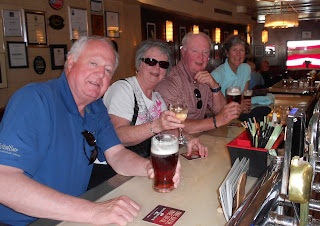One of the most interesting things I’ve learned on this trip
is that some things in the world, possibly many, are still handcrafted. I have
come to expect that most products are made in horrible factories in a third or
fourth world country by desperate people who are supposed to be grateful for
the appalling conditions. All controlled, of course, by evil corporations and
corrupt governments. Some of that is true, but not all.
I mentioned that 95% of Waterford Crystal is hand-cut (Did I
say that they make two of their one-off special pieces like awards, trophies,
or commemorative items, ‘just in case’? That’s commitment and thinking ahead.) and
we went to two other relatively famous, or at least well known, “factories” to
have a look.
The first was Avoca Hand Weavers; there’s an Avoca store in
downtown Victoria, or there was. Avoca is a tiny village south of Dublin,
accessed by some of the narrowest, twisty-est roads we encountered. The weaving
operation is just at the edge of the village and is supposed to be the oldest
business in operation in Ireland. There’s a cafe, and a shop on the right and,
across a small car park, the weaving and shipping building. We are not talking
big here, maybe 2000 square feet for production and shipping, and they ship all
over the world. There is literally a weaving room, not building, and the
process is astonishing. It can take up to 2 days to make the warp for a
specific pattern, threaded by hand, which is transferred to one of half a dozen
mechanical looms that run the weft shuttles. It’s a self-guided tour at Avoca,
with story boards on the walls explaining the Italian Fringe Cutter and various
other things, no guide, and you just stop and chat with the workers and wander
around the machines. They obviously have no fear of liability litigation, the
workers are happy to chat, and there might have been 8 of us in the place at
the time. A truly tiny, truly handmade, and truly beautiful process.
 |
| some of the end product |
 |
| building a warp |
 |
| the yarn shop |
A few days later we went to Belleek on a round-about route
to Belfast. Belleek the town might have 200 inhabitants on a busy day and is
situated west of everywhere except Donegal. The Belleek operation is posh and
polished and we had a guide to keep us out of trouble but still, for a famous
maker of china, it is ALL handmade! Someone makes the mold which is good for
only a few weeks, pours the slip, carries the pieces to the drying racks,
paints the designs, etcetera. The apprenticeships vary from 3-5 years depending
on the job. We talked to Rachel, who wears very long false eyelashes and has
been a painter for 24 years mostly doing shamrocks and twigs. Another young
woman was making flowers, one petal at a time. Seriously.
I have a completely different appreciation for these fine
products and, seeing the attention and detail that goes into them, they are
under-priced. Remarkable.
 |
| green-ware drying |
 |
| the kilns |
 |
| this mirror, in the museum, took 2 people one year to create |
 |
| Rachel of the long lashes and steady hand |
Is there anything comparable in North America? ‘Cuz if there
is I’d like to visit the place.



















































